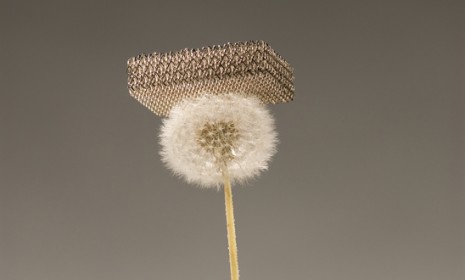'Microlattice': The world's lightest material?
An ultra-lightweight material that can rest atop a feathery dandelion has scientists walking on air

A team of researchers from UC Irvine, HRL Laboratories, and the California Institute of Technology claim to have created the "world's lightest" material. The findings, published in the Nov. 18 issue of the journal Science, say that the material is 100 times lighter than styrofoam, and capable of sitting atop a feathery dandelion without dispersing its seeds. Here's how it works:
First off, what is it?
Researchers call the material "ultralight metallic microlattice." (Watch a video demo below.) It consists of a series of interlocking hollow tubes made of nickel, each 1,000 times thinner than a human hair. The other 99.99 percent of microlattice is nothing but air, says Deborah Netburn at the Los Angeles Times. When dropped from shoulder height, the microlattice floats like a feather, taking upwards of 10 seconds to reach the ground.
The Week
Escape your echo chamber. Get the facts behind the news, plus analysis from multiple perspectives.

Sign up for The Week's Free Newsletters
From our morning news briefing to a weekly Good News Newsletter, get the best of The Week delivered directly to your inbox.
From our morning news briefing to a weekly Good News Newsletter, get the best of The Week delivered directly to your inbox.
But why exactly is it so light?
To grasp the anatomy of microlattice, think of the Eiffel Tower or the Golden Gate Bridge. Both structures use relatively small amounts of cleverly-arranged metal to hold a lot of weight. Microlattice has a similar structure. And because it uses such tiny amounts of metal, its density is "less than one-thousandth that of water," says Damon Poeter at PC Mag. Microlattice is still "pretty resilient," though. "When squashed to half its height, the material rebounds 98 percent of the way back."
What could microlattice be used for?
Such an ultra-lightweight, spongy material could have applications in a number of industries. It could, for instance, dampen accoustics to help soundproof walls, or be used for impact protection in the aerospace industry.
A free daily email with the biggest news stories of the day – and the best features from TheWeek.com
Watch how it works:
Sources: LA Times, PC Mag, United Press International
-
 Wilde Cambridge: home-away-from-home in a prime city spot
Wilde Cambridge: home-away-from-home in a prime city spotThe Week Recommends This laid-back aparthotel is the perfect base for a weekend of exploring
-
 The best alcohol-free alternatives for Dry January
The best alcohol-free alternatives for Dry JanuaryThe Week Recommends Whether emerging from a boozy Christmas, or seeking a change in 2026, here are some of the best non-alcoholic beers, wines and spirits to enjoy
-
 A lemon-shaped exoplanet is squeezing what we know about planet formation
A lemon-shaped exoplanet is squeezing what we know about planet formationUnder the radar It may be made from a former star